Cleopatra (1934)

British postcard in the "Filmshots" series by Film Weekly. Photo: Paramount. Henry Wilcoxon as Mark Antony and Claudette Colbert as Cleopatra in Cleopatra (Cecil B. DeMille, 1934).

British postcard in the "Filmshots" series by Film Weekly. Photo: Paramount. Warren William as Julius Caesar and Claudette Colbert as Cleopatra in Cleopatra (Cecil B. DeMille, 1934).
After his historical epic Sign of the Cross (1932), Cecil B. DeMille directed another ancient spectacle, Cleopatra (1934). His new star Claudette Colbert, fresh from her donkey milk bath in Sign of The Cross, played the politically shrewd, man-hungry queen of Egypt. In 48 BC, Cleopatra, facing palace revolt, welcomes the arrival of Julius Caesar (Warren William) as a way of solidifying her power under Rome. When Caesar, whom she has led astray, is killed, she transfers her affections to Marc Antony (Henry Wilcoxon) and dazzles him on a lavish barge. The film got five Oscar nominations, including one for Best Picture, and Victor Milner won the award for Best Cinematography.
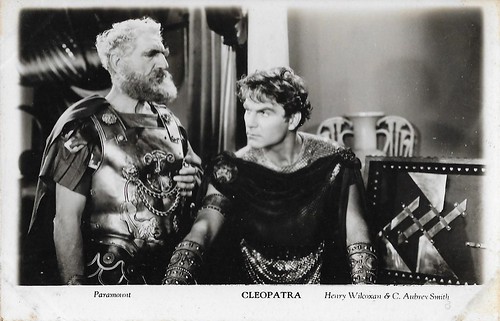
British postcard in the "Filmshots" series by Film Weekly. Photo: Paramount. Henry Wilcoxon as Mark Antony and C. Aubrey Smith as Enobarbus in Cleopatra (Cecil B. DeMille, 1934).
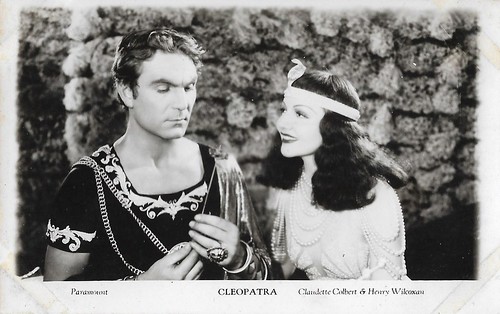
British postcard in the "Filmshots" series by Film Weekly. Photo: Paramount. Henry Wilcoxon as Mark Antony and Claudette Colbert as Cleopatra in Cleopatra (Cecil B. DeMille, 1934).
I Cover the Waterfront (1933)

British postcard in the "Filmshots" series by Film Weekly. Photo: United Artists. Claudette Colbert and Ernest Torrence in I Cover the Waterfront (James Cruze, 1933).

British postcard in the "Filmshots" series by Film Weekly. Photo: United Artists. Claudette Colbert, Ernest Torrence and Ben Lyon in I Cover the Waterfront (James Cruze, 1933). The other woman could be Claudia Coleman.
I Cover the Waterfront (James Cruze, 1933) is a tough pre-code drama set at the Californian waterfront. The film deals with Kirk, an old smuggler (Ernest Torrence in his final film role), who smuggles Chinese people into the country but has no remorse to throw his living cargo overboard when the police are after him. Yet, his daughter Julie (Claudette Colbert) remains loyal to him. An investigative reporter, Miller (Ben Lyon), bored of his area (he covers the waterfront, hence the title), is set on the case. He discovers a girl (Colbert) swimming naked at night and discovers she is the smuggler's daughter, so he woes her to get closer to the smuggler. She shows him the beauties of the waterfront, inspiring him to improve a novel he has been working on for years. However, unknowingly Julie betrays Kirk's next smuggle to Miller and he warns the Coast Guard. The whole affair ends badly for Kirk (he is deadly wounded), but not before he realizes Julie's love for Miller and manages to save Miller's life whom he has wounded himself.

British postcard in the "Filmshots" series by Film Weekly. Photo: United Artists. Claudette Colbert and Ben Lyon in I Cover the Waterfront (James Cruze, 1933).

British postcard in the "Filmshots" series by Film Weekly. Photo: United Artists. Claudette Colbert and Ernest Torrence in I Cover the Waterfront (James Cruze, 1933).
Jennie Gerhardt (1933)

British postcard in the "Filmshots" series by Film Weekly. Photo: Paramount. Sylvia Sidney and Donald Cook in Jennie Gerhardt (Marion Gering, 1933).

British postcard in the "Filmshots" series by Film Weekly. Photo: Paramount. Sylvia Sidney and Greta Meyer in Jennie Gerhardt (Marion Gering, 1933).
Jennie Gerhardt (1933) is an American pre-Code drama film directed by Marion Gering for Paramount Pictures. It stars Sylvia Sidney, Mary Astor, Donald Cook, Edward Arnold, and H.B. Warner. The film is based on the 1911 novel 'Jennie Gerhardt' by Theodore Dreiser. Jennie Gerhardt (Sylvia Sidney) is a destitute young woman. While working in a hotel in Columbus, Ohio, Jennie meets George Brander (Edward Arnold), a United States Senator, who becomes infatuated with her. He helps her family and declares his wish to marry her. Jennie, grateful for his benevolence, agrees to sleep with him. He dies before they marry, and Jennie is pregnant. Jenny meets Lester Kane (Donald Cook), a prosperous manufacturer's son. Jennie falls in love with him, impressed by his strong will and generosity. She leaves her daughter Vesta (Cora Sue Collins) in Cleveland and travels to New York with Kane. He does not know of her illegitimate daughter and wants to marry Jennie. But because of their difference in class, he anticipates his family's disapproval and decides to take her as his mistress. Dreiser himself approved of the film, considering it to be "moving" and "beautifully interpreted". However, the film received a mixed critical reception upon release in June 1933. Motion Picture Herald said that Jennie Gerhardt is "strictly an adult picture. Selling it successfully depends upon your ability to construct campaigns that will intrigue human interest and sympathy in the character of Jennie." Mordaunt Hall of The New York Times stated that "although the film is handicapped by a lack of suspense and some choppy and trite dialogue, it possesses a laudable sincerity, which may result in its being popular with those who are partial to this genre of story."

British postcard in the "Filmshots" series by Film Weekly. Photo: Paramount. Sylvia Sidney and Edward Arnold in Jennie Gerhardt (Marion Gering, 1933).

British postcard in the "Filmshots" series by Film Weekly. Photo: Paramount. Sylvia Sidney and Donald Cook in Jennie Gerhardt (Marion Gering, 1933).
The Bowery (1933)

British postcard in the "Filmshots" series by Film Weekly. Photo: Twentieth Century. Pert Kelton as dance hall performer Trixie Odbray with the chorus in The Bowery (Raoul Walsh, 1933).
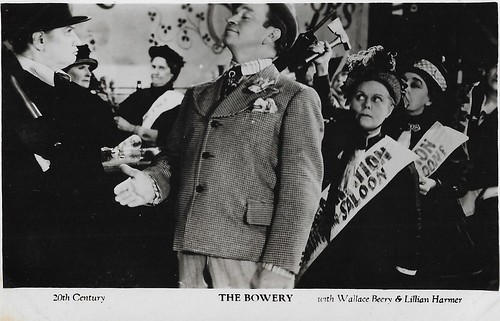
British postcard in the "Filmshots" series by Film Weekly. Photo: Twentieth Century. Wallace Beery and Lillian Harmer in The Bowery (Raoul Walsh, 1933).
The Bowery (Raoul Walsh, 1933) is set in the Gay Nineties in the Bowery in New York. Saloon owner Chuck Connors (Wallace Beery) is the king of the Bowery. He adopts a boy, Swipes (Jackie Cooper), and educates him in a rough way. Connors' rival, both as an upcoming saloon owner and in the voluntary fire brigade, is Steve Brodie (George Raft). Soon, both also become rivals in the love of Lucy (Fay Wray), a homeless girl Connors has saved - causing the jealous Swipes to move in with Brodie. Connors bets his saloon against Brodie to challenge him to jump off the Brooklyn Bridge. Brodie eventually does so when his plan to use a dummy falls through. Connors then sees no problem when temperance activists destroy his saloon. Until he hears about the dummy...

British postcard in the "Filmshots" series by Film Weekly. Photo: Twentieth Century. Wallace Beery and Jackie Cooper in The Bowery (Raoul Walsh, 1933).

British postcard in the "Filmshots" series by Film Weekly. Photo: Twentieth Century. Fay Wray and George Raft in The Bowery (Raoul Walsh, 1933).
Catherine the Great (1934)

British postcard in the "Filmshots" series by Film Weekly. Photo: London Films. Douglas Fairbanks Jr., Flora Robson, and Elisabeth Bergner in Catherine the Great (Paul Czinner, 1934).
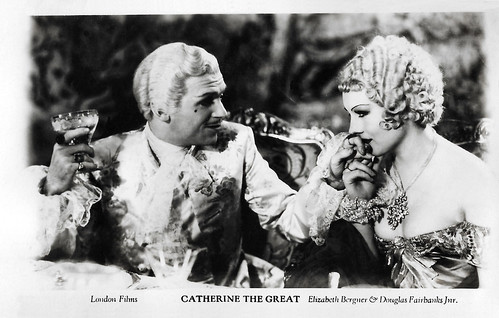
British postcard in the "Filmshots" series by Film Weekly. Photo: London Films. Publicity still for Catherine the Great (Paul Czinner, 1934). Although the postcard credits the kissing lady as Elisabeth Bergner, we think she is Diana Napier who portrays Countess Vorontzova, the mistress of Peter III (Douglas Fairbanks Jr.).
Catherine the Great/The Rise of Catherine the Great (1934) was the first English-language film for Vienna-born Elisabeth Bergner. She is radiant as the obscure German princess who would become the most powerful woman in Russian history. Bergner definitely makes Catherine interesting and worth caring about. The historical film was based on the play 'The Czarina' by two Hungarian writers, Lajos Bíró and Melchior Lengyel. It was directed by Bergner's husband Paul Czinner and - uncredited - by producer Alexander Korda. Grand Duke Pyotr, who later became Peter III, was played by Douglas Fairbanks Junior. He behaves like a homicidal Hamlet, all moodiness and flares of deadly temper. He makes an interesting effort to create a charmer out of a pathetic man who was obviously a maniac. The supporting cast is also excellent. Dame Flora Robson is wonderful as Empress Elizabeth: suspicious, domineering, and rather wanton. Celebrated stage actress Dame Irene Vanbrugh makes a rare screen appearance as Catherine's mother. The mid-eighteenth century was a period when clothes and furnishings favoured by the wealthy classes of Europe were particularly fanciful and elaborate, and this is reflected in the lavish sets and costumes on view in the film. Although the film was overshadowed by Josef von Sternberg's masterpiece The Scarlet Empress (1934) with Marlene Dietrich, Catherine the Great/The Rise of Catherine the Great is a good film taken on its own merits.

British postcard in the "Filmshots" series by Film Weekly. Photo: London Films. Irene Vanbrugh and Elisabeth Bergner in Catherine the Great (Paul Czinner, 1934).
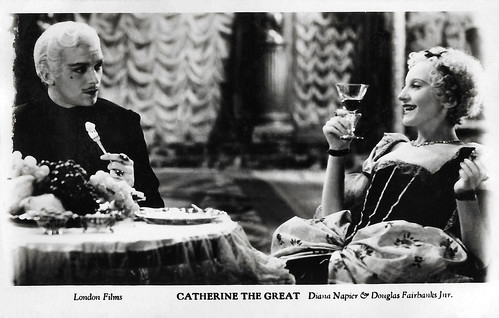
British postcard in the "Filmshots" series by Film Weekly. Photo: London Films. Douglas Fairbanks Jr. and Diana Napier in Catherine the Great (Paul Czinner, 1934).
Check out the three earlier Film Weekly posts at EFSP: 7 March 2020 including The Private Life of Henry VIII (1933), 14 March 2020 including A Farewell to Arms (1932), and 28 November 2020 including Christopher Strong (1933).
No comments:
Post a Comment